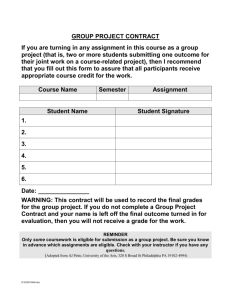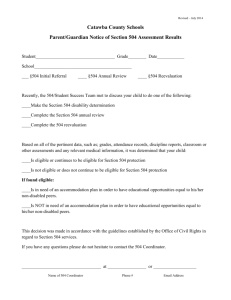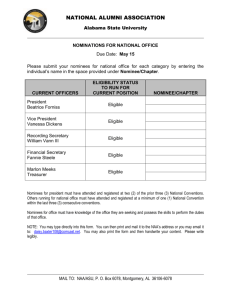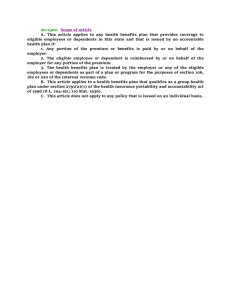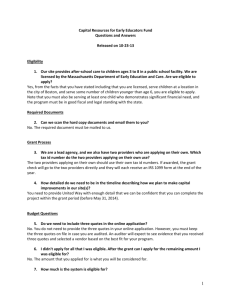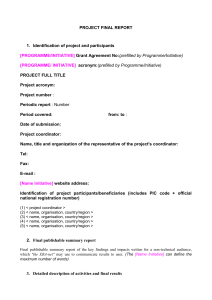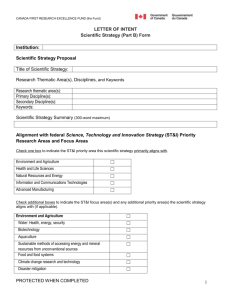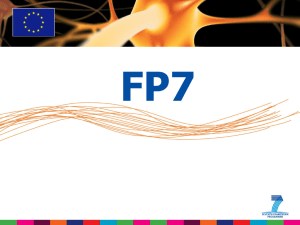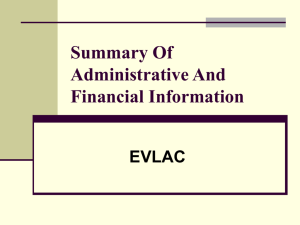05_Manage - Graduate School of Nanotechnology
advertisement
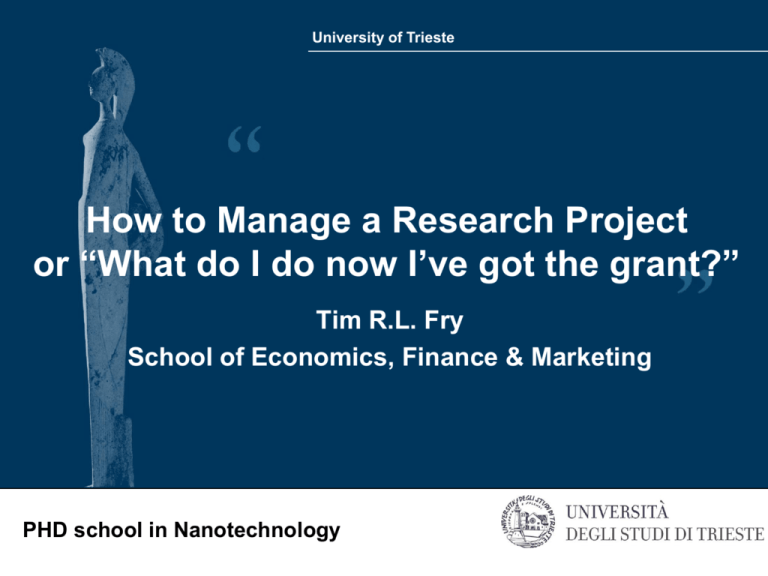
University of Trieste How to Manage a Research Project or “What do I do now I’ve got the grant?” Tim R.L. Fry School of Economics, Finance & Marketing PHD school in Nanotechnology What is a Project? • A planned undertaking [according to the webster dictionary] • A one-time endeavor, delineated by a start and a completion • A typical project will have: – – – – – – – A charter (or mission) Requirements/Specifications Deliverable(s) Resources (people, money, materials, time, knowledge) Constraints Risks Deadline(s) • The project manager is the facilitator for the project • Project Management is a “role” someone must play • Project Management deals with the art and science of making projects happen! Why need Project Management? • • • • Project Complexity Division of responsibilities - specialization Knowledge & Expertise – breadth vs.depth A typical tri-partite project leadership model: – – – – Business Lead – owner of the purpose (know why) Technical Lead – subject matter expert (know how) Project Manager – make happen (know when; know who) All Three – work as a team (all must know what) What do good project managers do? • They Manage the entire Project Life Cycle and make sure it aligns with the vision & mission (strategy & charter) • They Make Things Happen They Manage Resources : To Drive : •Time •Money •People •Intellectual Capital •Efficiency •Productivity •Effectiveness, & •Optimal Deployment of Resources How do they do it? • They Organize the Team • They Plan & schedule • They Manage the – – – – – – • • • • Deliverables Resources – time, money, people, knowledge Priorities Expectations Risks Project Life Cycle They Communicate They Monitor and Measure (set up metrics) They Document They Review, and make sure lessons are learned What did you get and what do you need? • Great to get the funding but were you: • Exactly funded? – Assuming that you correctly budgeted and costs haven’t changed then the project is on the starting grid. • Over funded? – Maybe you padded the budget or costs are not as high as projected. • Under funded? – Maybe the project wasn’t fully funded (time or funds cut) or costs have risen. What did you promise? • Revisit the project – – – – Can it still be done? Do you have to modify and, if so, how? Is it still viable? Can the stated outputs still be delivered? • Return to the funding body (bodies) for clarification. • Seek new or extra funds from elsewhere – Is this feasible? On the starting grid • Large amounts of paperwork to attend to! • Contract/Funding Agreement/Letter of Engagement – Terms and conditions. Timelines. Reporting requirements. • Prepare your budget – – – – When does the income arrive? What are you spending money on? When is the expenditure required? What are the rules – funding body and university – concerning expenditures? Starting the project • Most projects will involve you working with others • These could be others “on the grant” who might be – “equals”, “junior”, “senior” researchers • Do researchers need to be recruited? – Assistants, Associates, Fellows. • Are these recruits to hand or where might we find them? – How long will it take to recruit? Can they be found? Running the project • Manage your time, resources (people, equipment, money, space) – Does your school actually have the space and other resources required? – Budgets need to be assessed on a regular basis • Manage others’ time and resources – Deal with administrative issues such as time sheets • Hit milestones. • Produce Progress Reviews • Produce Reports/Outputs Closing thoughts • Successfully managing your successful research project requires a number of skills – – – – – Time management skills Resource management skills People management skills Negotiation skills Project management skills • NOT the skills that you made you successful in getting your project funded! RMIT University© Remember you actually have to do the research! ONE LAST THOUGHT … Project managements in practice • • • • • Project Coordination (GANTT) Meetings and communication flows Deliverables Milestones Financial issues Communication structures / Communication flows • • • • • • Meetings (scopi differenti) Phone conferences Web-based communication platforms (extranet) Internal newsletter,… Reporting structures Meetings: Deliverables • Example one (basic) • Example two (application and results) Milestones • One example University of Trieste Financial issues PHD school in Nanotechnology 1.Payment modalities – One pre-financing (upon entry into force) for the whole duration – Interim payments based on financial statements (payment = cost accepted * funding rate) – Retention (10%) – Final payment 2. Eligible Costs (1) – Eligible • actual* • during duration of project • in accordance with its usual accounting and management principles • recorded in the accounts of benficiary – non-eligible (identifiable indirect taxes including VAT…) 2. Eligible Costs (2) – *Average personnel costs accepted if : – Consistent with the management principles and accounting practices & – they do not significantly differ from actual personnel costs= if identified according to a methodology approved by the Commission (NEW) 3. Indirect Cost : • For all: – either actual overhead or simplified method – flat rate of 20% of direct costs minus subcontracting and 3rd parties not used on the premises of the beneficiary. • For Non profit Public Bodies, Secondary and Higher Education establishments, Research Organisations and SMEs unable to identify real indirect costs, may apply for a flat rate of 60% for funding schemes with RTD. 4. Certification (5) – – – – Who can provide these certificates : Qualified auditors under the 8th Directive Independent Public bodies, secondary and higher education establishments and research organisations may opt for a competent public officer Maximum reimbursement rates of eligible costs Research and technological development (*) Demonstration activities Training activities Management of the consortium activities Other activities (**) 100% 100% 100% 100% 100% 100% 100% 100% 100% (****) 100% (****) 100% (****) Network of excellence Collaborative project 50% 75% (***) Research project for the benefit of specific groups (SMEs) 50% 75% (***) Coordination and support action 50% 50% (*) Research and technological development includes operational activities directly related to the protection of foreground and coordination of research activities. (**) Other activities means any "specific activity" covered by Annex I. (***) For beneficiaries that are non profit public bodies, secondary and higher education establishments, research organisations and SMEs (****) The reimbursement of indirect eligible costs, in the case of coordination and support actions, may reach a maximum 7% of the direct eligible costs, excluding the direct eligible costs for subcontracting and the costs of reimbursement of resources made available by third parties which are not used on the premises of the beneficiary. Reporting (1) • Periodic reports to be submitted by coordinator 60 days after end of period: • - progress of the work • - use of the resources and • - Financial Statement (Form C) • Final reports to be submitted by coordinator 60 days after end of project: • - publishable summary report, conclusions and socioeconomic impact • - covering wider societal implications and a plan on use and dissemination of results Reporting (2) • Commission has 105 days to evaluate and execute the corresponding payment • No tacit approval • After reception Commission may: – – – – Approve Suspend the time-limit requesting revision/completion Reject them giving justification, possible termination Suspend the payment Dissemination • Define stakeholders – Accademia, Industria, Consumer groups, general public • Dissemination Plan – Websites, Pubblications, Workshop for industry • Presentations – Always make use of project template • Prepare flyers – following the template • Prepare newsletter – Translate it in all languages • Events – At least one event at the end of the project
